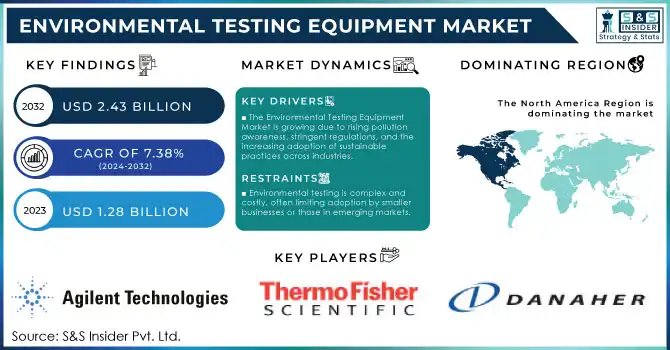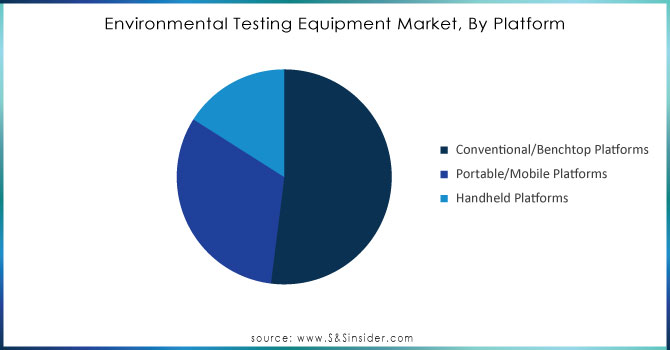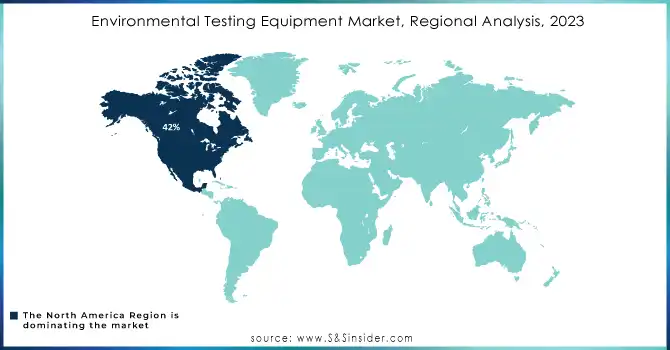Environmental Testing Equipment Market Report Scope & Overview:

Get More Information on Environmental Testing Equipment Market - Request Free Sample Report
The Environmental Testing Equipment Market Size was valued at USD 1.28 Billion in 2023 and is expected to reach USD 2.43 Billion by 2032 and grow at a CAGR of 7.38% over the forecast period 2024-2032.
The Environmental Testing Equipment market is witnessing significant growth due to increasing environmental concerns and the rising need for regulatory compliance across industries. As governments and organizations focus on sustainable practices, the demand for equipment that tests air, water, soil, and other environmental factors is growing. This equipment is used in various sectors such as automotive, aerospace, manufacturing, and environmental monitoring to ensure products and processes meet environmental standards. Technological advancements are significantly improving environmental testing equipment, with innovations like automated testing systems and real-time monitoring tools becoming increasingly common. This helps improve efficiency and ensures faster, more reliable results. Additionally, the integration of artificial intelligence (AI) and Internet of Things (IoT) technologies is helping streamline data collection and analysis, leading to improved decision-making and predictive insights.
Another trend is the growing adoption of portable and easy-to-use testing equipment. These devices allow for real-time, on-site testing, particularly in remote locations or field environments. With industries facing pressure to reduce their carbon footprint, there is a growing demand for testing solutions that can accurately measure emissions, water quality, and other environmental impacts. Companies that provide innovative, reliable, and cost-effective solutions are poised to capture significant market share, contributing to the overall growth of the market. Moreover, the continued push for greener technologies and heightened environmental awareness will further accelerate demand in the coming years.
Environmental Testing Equipment Market Dynamics
DRIVERS
-
The Environmental Testing Equipment Market is growing due to rising pollution awareness, stringent regulations, and the increasing adoption of sustainable practices across industries.
The Environmental Testing Equipment Market is witnessing robust growth, driven by rising global awareness of pollution, climate change, and environmental degradation. Expanding industrial activities and urbanization have intensified environmental pressures, increasing the demand for advanced testing solutions to monitor air, water, and soil quality. Governments worldwide are enforcing stricter regulations on emissions, waste management, and environmental compliance, compelling industries to invest in sophisticated testing equipment to meet these standards. These devices provide precise, real-time data crucial for assessing and mitigating the environmental impacts of industrial and agricultural activities. Industries such as manufacturing, energy, and agriculture are increasingly adopting innovative environmental testing technologies to align with sustainable practices and regulatory demands. These advancements not only help industries reduce their ecological footprint but also bolster market growth by fostering technological innovation. Moreover, research institutions and environmental organizations play a pivotal role in driving demand by conducting extensive studies on climate change, pollution, and ecosystem health, necessitating the use of highly specialized testing tools.
RESTRAIN
-
Environmental testing is complex and costly, often limiting adoption by smaller businesses or those in emerging markets.
The complexity of environmental testing processes, which includes sample collection, preparation, and analysis, presents a significant challenge for many businesses, particularly smaller enterprises or those in emerging markets. These processes require specialized knowledge, precise procedures, and sometimes sophisticated equipment to ensure accurate results. For instance, air quality testing may involve complex sampling techniques and the need for stringent calibration of instruments to ensure reliable data. Similarly, water and soil testing often demand labor-intensive preparations, such as filtration or chemical treatments, before analysis can be conducted. These intricate procedures can be time-consuming and require highly skilled personnel, which adds to operational costs and complexity.
As a result, the high level of expertise and resources required for environmental testing can deter companies from adopting advanced testing equipment, especially in industries or regions with limited access to skilled technicians. This creates a barrier to market growth as businesses may opt for less accurate or simpler methods, delaying the widespread adoption of cutting-edge environmental testing solutions.
Environmental Testing Equipment Market Segmentation Analysis
By Platform
The Conventional/Benchtop Platforms segment dominated with the market share over 52% in 2023, primarily due to their high accuracy and ability to conduct detailed, high-capacity analyses. These platforms are widely used in laboratory environments where precision and comprehensive testing are essential. They offer reliable results, making them a preferred choice for in-depth research and complex environmental testing tasks. However, the growth of benchtop platforms is slower compared to portable options, as industries increasingly demand more flexible and adaptable solutions. The shift toward portable and mobile platforms is driven by the need for real-time, on-site testing, which is more convenient for field applications in environmental monitoring, construction, and safety.

Need any customization research on Environmental Testing Equipment Market - Enquiry Now
By End-use Industry
The Environmental Testing Laboratories segment dominated with the market share over 38% in 2023, due to the essential role these laboratories play in environmental monitoring. These facilities use advanced testing equipment to assess air, water, soil, and waste quality, ensuring compliance with stringent environmental regulations. They conduct both routine testing, such as air quality monitoring and water testing, and more complex analyses, including hazardous waste detection and environmental impact assessments. As governments and industries enforce stricter environmental standards, the demand for accurate and reliable testing services has increased. Environmental testing laboratories are central to the detection and prevention of environmental contamination, making them a significant driver for the market.
Environmental Testing Equipment Market Regional Overview
The North American region dominated with the market share over in 42% 2023, primarily due to its stringent regulatory frameworks and advanced technological infrastructure. In countries like the United States and Canada, strict environmental laws and regulations, such as those enforced by the EPA, compel industries to implement rigorous environmental testing to ensure compliance. This demand spans across sectors like manufacturing, construction, energy, and pharmaceuticals. Moreover, North America's leadership in innovation and high investments in research and development fuel the creation of cutting-edge testing solutions. The region's robust infrastructure and the presence of major environmental testing companies, along with their commitment to sustainability, further strengthen its market dominance.
Asia-Pacific is the fastest-growing region in the Environmental Testing Equipment Market. The rapid industrialization in countries like China, India, and Japan is leading to increased environmental concerns, necessitating the adoption of testing equipment for air, water, and soil quality monitoring. Additionally, growing urbanization, government initiatives for environmental sustainability, and rising awareness of pollution are propelling the demand for environmental testing solutions in the region. The significant investments in infrastructure and manufacturing sectors make Asia-Pacific a key player in the market’s expansion.

Some of the major key players of Environmental Testing Equipment Market
-
Agilent Technologies Inc.: (Gas Chromatographs, Liquid Chromatographs, Mass Spectrometers)
-
Thermo Fisher Scientific Inc.: (Environmental Monitors, Water Quality Analyzers, Air Quality Testing Equipment)
-
Shimadzu Corporation: (Spectrophotometers, Mass Spectrometers, Chromatography Systems)
-
Waters Corporation: (LCMS, Gas Chromatography Systems, Water Testing Equipment)
-
Bruker Corporation: (Spectrometers, Microscopes, Elemental Analyzers)
-
PerkinElmer Inc.: (Air and Water Testing Instruments, Spectrometers, Chromatography Equipment)
-
Merck KGaA: (Analytical Instruments, Water Testing Kits, pH Meters)
-
Danaher Corporation: (Water Quality Testing Instruments, Air Quality Monitors, Detection Systems)
-
JEOL Ltd.: (Electron Microscopes, Mass Spectrometers, Analytical Instruments)
-
Endress+Hauser Group Services AG: (pH Meters, Oxygen Analyzers, Flow Meters)
-
JASCO Corporation: (UV-Vis Spectrophotometers, Chromatographs, Water Quality Analyzers)
-
Teledyne Technologies Incorporated: (Gas and Air Quality Monitors, Water Analysis Systems)
-
AMETEK, Inc.: (Gas Analyzers, Particle Analyzers, Water Quality Testers)
-
INFICON: (Leak Detectors, Gas Analysis Systems, Environmental Testing Equipment)
-
Horiba Ltd.: (Environmental Analyzers, Gas Detectors, Water Testing Equipment)
-
RKI Instruments, Inc.: (Gas Detectors, Environmental Monitoring Equipment)
-
Ametek Process Instruments: (Flow Analyzers, Gas Analyzers, Liquid Analysis Systems)
-
Sigma-Aldrich: (Environmental Testing Kits, Analytical Reagents, Water Quality Test Kits)
-
Analytik Jena AG: (Spectrometers, Water Testing Instruments, Environmental Monitoring Equipment)
-
Envisys Technologies: (launched VISTARA Labs: offering a wide range of environmental testing services)
Suppliers (including air and water testing and pollution analysis) Environmental Testing Equipment Market
-
Thermo Fisher Scientific
-
Horiba Ltd.
-
Agilent Technologies
-
ABB Group
-
Endress+Hauser
-
Testo SE & Co. KGaA
-
PerkinElmer Inc.
-
Teledyne Technologies Incorporated
-
RSG Inc.
-
SUEZ Water Technologies & Solutions
RECENT DEVELOPMENT
-
In September 2024: Montrose Environmental Group acquired Origins Laboratory in Denver, Colorado, to strengthen its presence in the Rocky Mountain region and expand its environmental testing capabilities. This acquisition enhances the company’s ability to meet the growing demand for comprehensive testing services amidst evolving regulations.
-
In August 2024: Envisys Technologies launched VISTARA Labs in Bengaluru, India, offering a wide range of environmental testing services across industries like electronics, automotive, defense, and aerospace. The lab provides essential testing such as humidity, temperature, dust, vibration, rain, and corrosion to support the increasing demand for thorough environmental assessments.
| Report Attributes | Details |
|---|---|
| Market Size in 2023 | USD 1.28 Billion |
| Market Size by 2032 | USD 2.43 Billion |
| CAGR | CAGR of 7.38% From 2024 to 2032 |
| Base Year | 2023 |
| Forecast Period | 2024-2032 |
| Historical Data | 2020-2022 |
| Report Scope & Coverage | Market Size, Segments Analysis, Competitive Landscape, Regional Analysis, DROC & SWOT Analysis, Forecast Outlook |
| Key Segments | • By Product (Mass Spectrometers, GC-MS Instruments, LC-MS Instruments, ICP-MS Instruments, Chromatography Products, Gas Chromatography, Liquid Chromatography, Molecular Spectroscopy Instruments, TOC Analyzers, pH Meters, Dissolved Oxygen Analyzers, Conductivity Sensors, Turbidity Meters, Others) • By Platform (Conventional/Benchtop Platforms, Portable/Mobile Platforms, Handheld Platforms) • By Application (Water Quality Testing, Organic Pollutants, PFAS (Poly- and Perfluoroalkyl Substances), Solid Pollutants, Heavy Metals, Microbial and Other Water Pollutants, Air Quality Testing, Volatile Organic Pollutants, Other Air Pollutants, Soil Quality Testing, Pesticides, Heavy Metals, Other Soil Pollutants) • By End-use Industry (Government Agencies and Municipal Authorities, Environmental Testing Laboratories, Industrial Facilities, Commercial & Residential Facilities, Others) |
| Regional Analysis/Coverage | North America (US, Canada, Mexico), Europe (Eastern Europe [Poland, Romania, Hungary, Turkey, Rest of Eastern Europe] Western Europe [Germany, France, UK, Italy, Spain, Netherlands, Switzerland, Austria, Rest of Western Europe]), Asia Pacific (China, India, Japan, South Korea, Vietnam, Singapore, Australia, Rest of Asia Pacific), Middle East & Africa (Middle East [UAE, Egypt, Saudi Arabia, Qatar, Rest of Middle East], Africa [Nigeria, South Africa, Rest of Africa], Latin America (Brazil, Argentina, Colombia, Rest of Latin America) |
| Company Profiles | Agilent Technologies Inc., Thermo Fisher Scientific Inc., Shimadzu Corporation, Waters Corporation, Bruker Corporation, PerkinElmer Inc., Merck KGaA, Danaher Corporation, JEOL Ltd., Endress+Hauser Group Services AG, JASCO Corporation, Teledyne Technologies Incorporated, AMETEK, Inc., INFICON, Horiba Ltd., RKI Instruments, Inc., Ametek Process Instruments, Sigma-Aldrich, Analytik Jena AG, Xylem Inc. |
| Key Drivers | • Rising awareness of pollution, climate change, and environmental degradation is fueling demand for environmental testing equipment |
| RESTRAINTS | • The complexity of environmental testing processes may limit adoption, but it is fueling demand for automated, user-friendly technologies, driving market growth. |

